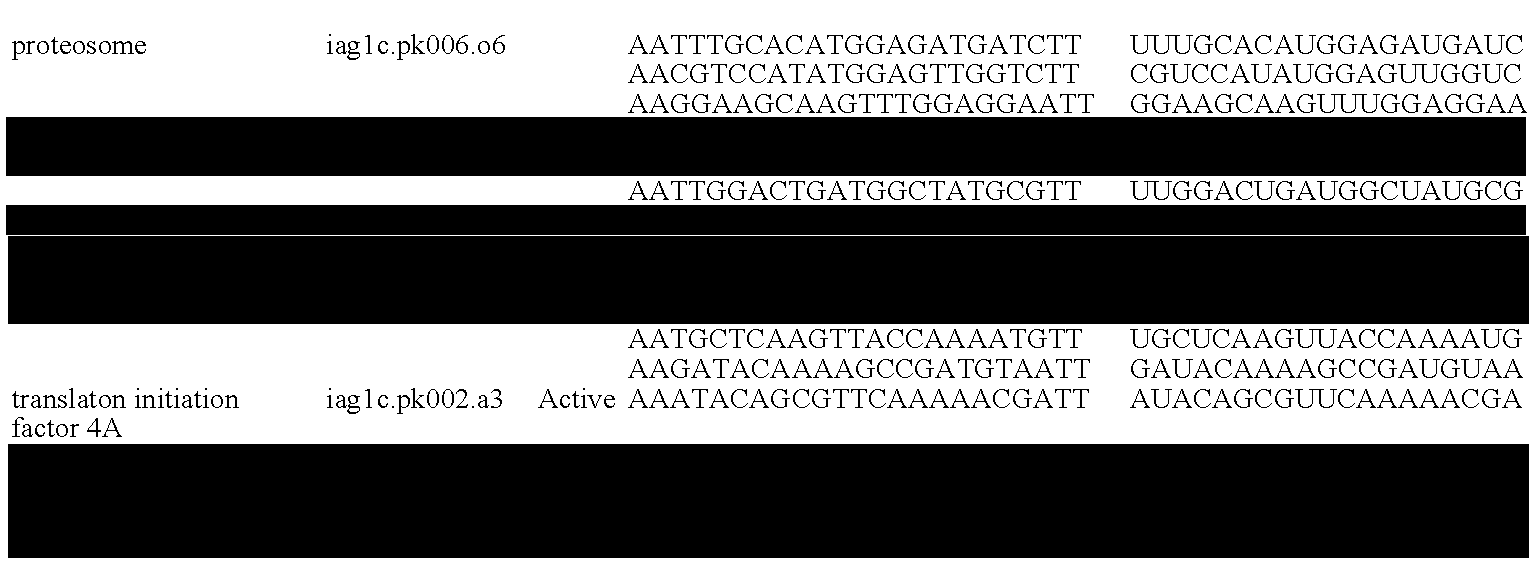Compositions and methods for the suppression of target polynucleotides from the family aphididae
a technology of target polynucleotides and aphidae, which is applied in the field of molecular biology and gene silencing to control pests, can solve the problems of destroying millions of acres of staple crops, $100 billion in crop damage, and serious problems of insect pests, so as to reduce the level of a target sequence, control the pest, and reduce the level of the target sequence
- Summary
- Abstract
- Description
- Claims
- Application Information
AI Technical Summary
Benefits of technology
Problems solved by technology
Method used
Image
Examples
example 1
Specific Target Genes and Silencing Elements that Cause Insecticidal Activity Against Aphis glycines
[0119]Disruption of insect gene function via RNAi can produce specific activity against target insects. This specificity is enhanced by delivery of the dsRNAs via transgenic plants. Identification of gene function in insects via RNAi has been largely limited to injection of dsRNAs. In fact, past experiments have indicated that insects are not capable of systemic RNAi response based on exposure to dsRNAs.
[0120]As described below, we have demonstrated acute activity of numerous dsRNA pairs through injection experiments and additionally have demonstrated insect antagonism through ingestion of dsRNAs. This evidence identifies several gene / primer pair combinations with clear insecticidal properties. The use of dsRNAs in transgenic plants also addresses the potential complication of heterologous protein expression and the possible risks of allergic reaction, non-target activity, and enviro...
example 2
Transformation of Maize
[0145]Immature maize embryos from greenhouse donor plants are bombarded with a plasmid containing the silencing element of the invention operably linked to a PP2 promoter from pumpkin and the selectable marker gene PAT (Wohlleben et al. (1988) Gene 70:25-37), which confers resistance to the herbicide Bialaphos. Alternatively, the selectable marker gene is provided on a separate plasmid. Transformation is performed as follows. Media recipes follow below.
Preparation of Target Tissue
[0146]The ears are husked and surface sterilized in 30% Clorox bleach plus 0.5% Micro detergent for 20 minutes, and rinsed two times with sterile water. The immature embryos are excised and placed embryo axis side down (scutellum side up), 25 embryos per plate, on 560Y medium for 4 hours and then aligned within the 2.5 cm target zone in preparation for bombardment.
[0147]A plasmid vector comprising the silencing element of interest operably linked to a PP2 promoter is made. This plasmi...
example 3
Agrobacterium-Mediated Transformation of Maize
[0154]For Agrobacterium-mediated transformation of maize with a silencing element of the invention, the method of Zhao is employed (U.S. Pat. No. 5,981,840, and PCT patent publication WO98 / 32326; the contents of which are hereby incorporated by reference). Briefly, immature embryos are isolated from maize and the embryos contacted with a suspension of Agrobacterium, where the bacteria are capable of transferring the polynucleotide comprising the silencing element to at least one cell of at least one of the immature embryos (step 1: the infection step). In this step the immature embryos are immersed in an Agrobacterium suspension for the initiation of inoculation. The embryos are co-cultured for a time with the Agrobacterium (step 2: the co-cultivation step). The immature embryos are cultured on solid medium following the infection step. Following this co-cultivation period an optional “resting” step is contemplated. In this resting step,...
PUM
| Property | Measurement | Unit |
|---|---|---|
| Fraction | aaaaa | aaaaa |
| Fraction | aaaaa | aaaaa |
| Time | aaaaa | aaaaa |
Abstract
Description
Claims
Application Information
 Login to View More
Login to View More - R&D
- Intellectual Property
- Life Sciences
- Materials
- Tech Scout
- Unparalleled Data Quality
- Higher Quality Content
- 60% Fewer Hallucinations
Browse by: Latest US Patents, China's latest patents, Technical Efficacy Thesaurus, Application Domain, Technology Topic, Popular Technical Reports.
© 2025 PatSnap. All rights reserved.Legal|Privacy policy|Modern Slavery Act Transparency Statement|Sitemap|About US| Contact US: help@patsnap.com



